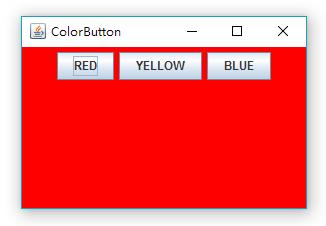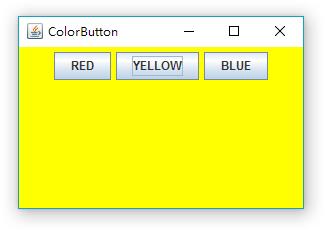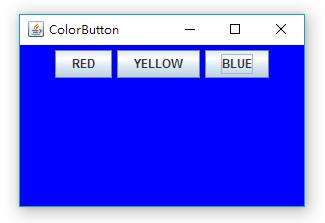GUI event processing basics
Event processing can be simply understood this way. When an event occurs, the program must respond according to this event. For example, we made a window that can change the background color through a button. When we click the button, an event is generated, and the program will respond according to this event, that is, to change the background color.
So how does the program respond? This requires the event listener ActionListener, which is an interface that contains the actionPerformed method (that is, the operation performed based on the event), so we need to implement this interface (implement the actionPerformed method in the interface) to make a listener object. , and use the button to register the listener object, so that when the button is clicked, the listener will be called to perform the response.



Running results
Code (starting from line 42 to implement the interface):
package buttonPanel;
import java.awt.*;
import java.awt.event.*; //事件监听器接口ActionListener的位置。
import javax.swing.*;
public class ButtonFrame extends JFrame {
private ButtonPanel buttonPanel;
private static final int DEFAULT_WIDTH = 300;
private static final int DEFAULT_HEIGHT = 200;
public ButtonFrame() {
setSize(DEFAULT_WIDTH,DEFAULT_HEIGHT);
setLocationByPlatform(true);
//构造按钮
JButton redButton = new JButton("RED");
JButton yellowButton = new JButton("YELLOW");
JButton blueButton = new JButton("BLUE");
buttonPanel = new ButtonPanel();
//添加按钮到面板
buttonPanel.add(redButton);
buttonPanel.add(yellowButton);
buttonPanel.add(blueButton);
add(buttonPanel);
//构造对应颜色的动作监听器
ColorAction redAction = new ColorAction(Color.red);
ColorAction yellowAction = new ColorAction(Color.yellow);
ColorAction blueAction = new ColorAction(Color.blue);
//每个按钮注册对应的监听器
redButton.addActionListener(redAction);
yellowButton.addActionListener(yellowAction);
blueButton.addActionListener(blueAction);
}
//为了方便调用buttonPanel,将ColorAction作为ButtonFrame的内部类。
private class ColorAction implements ActionListener {
private Color backgroundColor;
public ColorAction(Color c) {
backgroundColor = c;
}
public void actionPerformed(ActionEvent event) {
buttonPanel.setBackground(backgroundColor);
}
}
public static void main(String[] args) {
EventQueue.invokeLater(new Runnable() {
public void run() {
JFrame frame = new ButtonFrame();
frame.setTitle("ColorButton");
frame.setDefaultCloseOperation(EXIT_ON_CLOSE);
frame.setVisible(true);
}
});
}
}
class ButtonPanel extends JPanel {
private static final int DEFAUT_WIDTH = 300;
private static final int DEFAUT_HEIGHT = 200;
@Override
protected void paintComponent(Graphics g) {
g.create();
super.paintComponent(g);
}
@Override
public Dimension getPreferredSize() {
return new Dimension(DEFAUT_WIDTH,DEFAUT_HEIGHT);
}
}In the above code, in order to facilitate the listener to call buttonPanel, ColorAction is used as the internal class of ButtonFrame. If you separate the ColorAction class, you need to pass the buttonPanel to the ColorAction. The implementation is as follows:
package buttonPanel2;
import java.awt.*;
import java.awt.event.*;
import javax.swing.*;
public class ButtonFrame2 extends JFrame {
private ButtonPanel buttonPanel;
private static final int DEFAULT_WIDTH = 300;
private static final int DEFAULT_HEIGHT = 200;
public ButtonFrame2() {
setSize(DEFAULT_WIDTH,DEFAULT_HEIGHT);
setLocationByPlatform(true);
JButton redButton = new JButton("RED");
JButton yellowButton = new JButton("YELLOW");
JButton blueButton = new JButton("BLUE");
buttonPanel = new ButtonPanel();
buttonPanel.add(redButton);
buttonPanel.add(yellowButton);
buttonPanel.add(blueButton);
add(buttonPanel);
//将此对象通过this传到ColorAction的构造器。
ColorAction redAction = new ColorAction(this,Color.red);
ColorAction yellowAction = new ColorAction(this,Color.yellow);
ColorAction blueAction = new ColorAction(this,Color.blue);
redButton.addActionListener(redAction);
yellowButton.addActionListener(yellowAction);
blueButton.addActionListener(blueAction);
}
public void setButtonPanelsBackground(Color backgroundColor) {
buttonPanel.setBackground(backgroundColor);
}
public static void main(String[] args) {
EventQueue.invokeLater(new Runnable() {
public void run() {
JFrame frame = new ButtonFrame2();
frame.setTitle("ColorButton");
frame.setDefaultCloseOperation(EXIT_ON_CLOSE);
frame.setVisible(true);
}
});
}
}
class ColorAction implements ActionListener {
private ButtonFrame2 buttonFrame;
private Color backgroundColor;
//通过构造器的方法把ButtonFrame2对象传过来,这个对象包含了成员变量buttonPanel,以便对其更换背景色。
public ColorAction(ButtonFrame2 buttonFrame,Color c) {
this.buttonFrame = buttonFrame; //this.buttonFrame只是对象管理者,管理的还是ButtonFrame的对象frame。
backgroundColor = c;
}
public void actionPerformed(ActionEvent event) {
buttonFrame.setButtonPanelsBackground(backgroundColor);
//这是我们在ButtonFrame2中添加的新方法。
}
}
class ButtonPanel extends JPanel {
private static final int DEFAUT_WIDTH = 300;
private static final int DEFAUT_HEIGHT = 200;
public ButtonPanel() {
setBackground(Color.pink);
}
@Override
protected void paintComponent(Graphics g) {
g.create();
super.paintComponent(g);
}
@Override
public Dimension getPreferredSize() {
return new Dimension(DEFAUT_WIDTH,DEFAUT_HEIGHT);
}
}
ButtonFrame2There is a flaw in the code, that is, there is code duplication when constructing the button, adding the button to the panel, constructing the listener of the corresponding color, and registering the listener. In order to avoid code duplication, we can create a makeButton method to include these repeated operations, as follows:
package buttonPanel3;
import java.awt.*;
import java.awt.event.*;
import javax.swing.*;
public class ButtonFrame3 extends JFrame {
private ButtonPanel buttonPanel;
private static final int DEFAULT_WIDTH = 300;
private static final int DEFAULT_HEIGHT = 200;
public ButtonFrame3() {
setSize(DEFAULT_WIDTH,DEFAULT_HEIGHT);
setLocationByPlatform(true);
buttonPanel = new ButtonPanel();
add(buttonPanel);
makeButton("RED",Color.red);
makeButton("YELLOW",Color.yellow);
makeButton("BLUE",Color.blue);
}
//为了避免代码重复,我们将重复的操作放在这个函数里。
public void makeButton(String name,final Color bg) {
JButton button = new JButton(name);
buttonPanel.add(button);
button.addActionListener(new ActionListener() { //可以new一个接口出来,但是后面必须接花括号实现内部方法。
public void actionPerformed(ActionEvent event) {
buttonPanel.setBackground(bg);
}
});
}
public static void main(String[] args) {
EventQueue.invokeLater(new Runnable() {
public void run() {
JFrame frame = new ButtonFrame3();
frame.setTitle("ColorButton");
frame.setDefaultCloseOperation(EXIT_ON_CLOSE);
frame.setVisible(true);
}
});
}
}
class ButtonPanel extends JPanel {
private static final int DEFAUT_WIDTH = 300;
private static final int DEFAUT_HEIGHT = 200;
@Override
protected void paintComponent(Graphics g) {
g.create();
super.paintComponent(g);
}
@Override
public Dimension getPreferredSize() {
return new Dimension(DEFAUT_WIDTH,DEFAUT_HEIGHT);
}
}
ButtonFrame3In the code, the listener is only called once, that is, when addActionListener(). So we don't need to make a separate class for the listener. Instead, we only need to create a new ActionListener interface directly when using the listener, and implement the interface method in curly braces.

Hot AI Tools

Undresser.AI Undress
AI-powered app for creating realistic nude photos

AI Clothes Remover
Online AI tool for removing clothes from photos.

Undress AI Tool
Undress images for free

Clothoff.io
AI clothes remover

Video Face Swap
Swap faces in any video effortlessly with our completely free AI face swap tool!

Hot Article

Hot Tools

Notepad++7.3.1
Easy-to-use and free code editor

SublimeText3 Chinese version
Chinese version, very easy to use

Zend Studio 13.0.1
Powerful PHP integrated development environment

Dreamweaver CS6
Visual web development tools

SublimeText3 Mac version
God-level code editing software (SublimeText3)

Hot Topics
 1670
1670
 14
14
 1428
1428
 52
52
 1329
1329
 25
25
 1274
1274
 29
29
 1256
1256
 24
24
 PHP: A Key Language for Web Development
Apr 13, 2025 am 12:08 AM
PHP: A Key Language for Web Development
Apr 13, 2025 am 12:08 AM
PHP is a scripting language widely used on the server side, especially suitable for web development. 1.PHP can embed HTML, process HTTP requests and responses, and supports a variety of databases. 2.PHP is used to generate dynamic web content, process form data, access databases, etc., with strong community support and open source resources. 3. PHP is an interpreted language, and the execution process includes lexical analysis, grammatical analysis, compilation and execution. 4.PHP can be combined with MySQL for advanced applications such as user registration systems. 5. When debugging PHP, you can use functions such as error_reporting() and var_dump(). 6. Optimize PHP code to use caching mechanisms, optimize database queries and use built-in functions. 7
 PHP vs. Python: Understanding the Differences
Apr 11, 2025 am 12:15 AM
PHP vs. Python: Understanding the Differences
Apr 11, 2025 am 12:15 AM
PHP and Python each have their own advantages, and the choice should be based on project requirements. 1.PHP is suitable for web development, with simple syntax and high execution efficiency. 2. Python is suitable for data science and machine learning, with concise syntax and rich libraries.
 Break or return from Java 8 stream forEach?
Feb 07, 2025 pm 12:09 PM
Break or return from Java 8 stream forEach?
Feb 07, 2025 pm 12:09 PM
Java 8 introduces the Stream API, providing a powerful and expressive way to process data collections. However, a common question when using Stream is: How to break or return from a forEach operation? Traditional loops allow for early interruption or return, but Stream's forEach method does not directly support this method. This article will explain the reasons and explore alternative methods for implementing premature termination in Stream processing systems. Further reading: Java Stream API improvements Understand Stream forEach The forEach method is a terminal operation that performs one operation on each element in the Stream. Its design intention is
 PHP vs. Other Languages: A Comparison
Apr 13, 2025 am 12:19 AM
PHP vs. Other Languages: A Comparison
Apr 13, 2025 am 12:19 AM
PHP is suitable for web development, especially in rapid development and processing dynamic content, but is not good at data science and enterprise-level applications. Compared with Python, PHP has more advantages in web development, but is not as good as Python in the field of data science; compared with Java, PHP performs worse in enterprise-level applications, but is more flexible in web development; compared with JavaScript, PHP is more concise in back-end development, but is not as good as JavaScript in front-end development.
 PHP vs. Python: Core Features and Functionality
Apr 13, 2025 am 12:16 AM
PHP vs. Python: Core Features and Functionality
Apr 13, 2025 am 12:16 AM
PHP and Python each have their own advantages and are suitable for different scenarios. 1.PHP is suitable for web development and provides built-in web servers and rich function libraries. 2. Python is suitable for data science and machine learning, with concise syntax and a powerful standard library. When choosing, it should be decided based on project requirements.
 PHP's Impact: Web Development and Beyond
Apr 18, 2025 am 12:10 AM
PHP's Impact: Web Development and Beyond
Apr 18, 2025 am 12:10 AM
PHPhassignificantlyimpactedwebdevelopmentandextendsbeyondit.1)ItpowersmajorplatformslikeWordPressandexcelsindatabaseinteractions.2)PHP'sadaptabilityallowsittoscaleforlargeapplicationsusingframeworkslikeLaravel.3)Beyondweb,PHPisusedincommand-linescrip
 PHP: The Foundation of Many Websites
Apr 13, 2025 am 12:07 AM
PHP: The Foundation of Many Websites
Apr 13, 2025 am 12:07 AM
The reasons why PHP is the preferred technology stack for many websites include its ease of use, strong community support, and widespread use. 1) Easy to learn and use, suitable for beginners. 2) Have a huge developer community and rich resources. 3) Widely used in WordPress, Drupal and other platforms. 4) Integrate tightly with web servers to simplify development deployment.
 PHP vs. Python: Use Cases and Applications
Apr 17, 2025 am 12:23 AM
PHP vs. Python: Use Cases and Applications
Apr 17, 2025 am 12:23 AM
PHP is suitable for web development and content management systems, and Python is suitable for data science, machine learning and automation scripts. 1.PHP performs well in building fast and scalable websites and applications and is commonly used in CMS such as WordPress. 2. Python has performed outstandingly in the fields of data science and machine learning, with rich libraries such as NumPy and TensorFlow.




